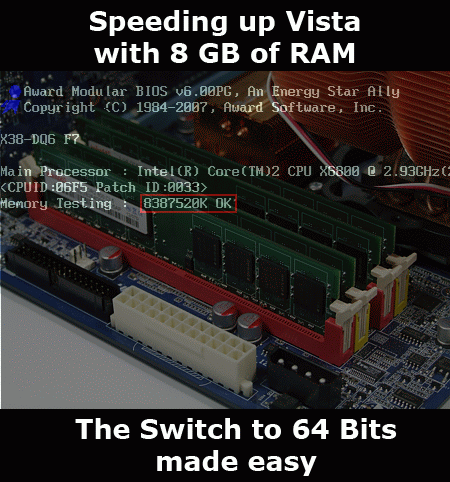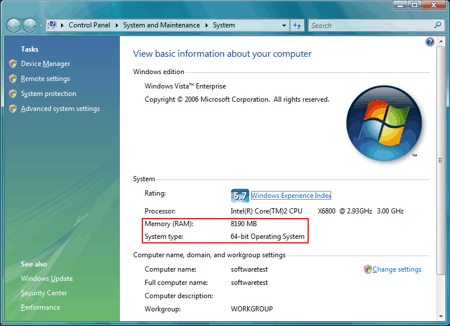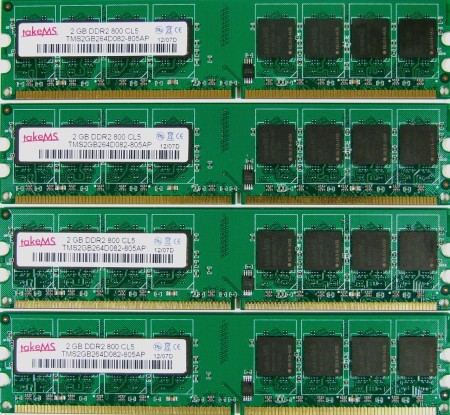Vista Workshop: More RAM, More Speed
Windows Vista With 8 GB
Throughout the history of personal computers, RAM has always been something of a valuable commodity - even a luxury. Only a few years ago, even reaching the memory limit of 4 GB possible under a 32 bit operating system was completely unthinkable. But then again, at one time 640 kB was considered enough for anyone. Times change; right now, DDR2 memory is as cheap as it's ever been Compare Prices on DDR2 Memory, and equipping your PC with 8 GB will only set you back about $198.
The benefit of having 8 GB of system memory is that the OS has to access the hard drive far less frequently, making Vista feel much snappier. However, several settings in the BIOS and the operating system need to be changed in order for the system to be able to take advantage of that much memory. Vista 64 still faces a few challenges, not the least of which is often a lack of drivers, though at least most standard applications run without issues. On the other hand, none of the current generation of applications can come even remotely close to utilizing the maximum amount of memory installable.
Widows Vista recognizes the full 8 GB of system memory.
Most users will be sobered when they equip their systems with 4 GB of RAM and find that only 3 GB is recognized by the BIOS and by Windows. This is neither a bug nor due to any hardware error. The explanation is simple: 32 bit systems can only address up to 4 GB of memory. Additionally, many add-in cards and on-board controllers require memory addresses in order to be accessible. This is called "Memory Mapped IO" (MMIO). Since this memory range has to lie within the 4 GB, it is subtracted from the installed and available RAM.
8 GB can already be had for less than $220.
Thanks to a technique called memory remapping, it is possible to move around parts of the system memory in such a way that the full 4 GB is still available for use. The trouble is that this feature had to be deactivated in Windows Vista due to compatibility issues.
In order to be able to utilize the entire system memory, you will therefore need to use a 64 bit version of Windows Vista. In this article, we will take a look at memory usage under the 32 bit and 64 bit versions of Windows Vista, and analyze how the operating system behaves with different amounts of RAM.
Get Tom's Hardware's best news and in-depth reviews, straight to your inbox.
-
trifler We need to see benchmarks comparing Vista with 2MB, 4MB, and 8MB. I can't tell my boss that the new high-end computers should have 8MB without some numbers.Reply -
I think meant GB not MB there Trifler... 8MB of ram is not very much... and a "high-end computer" should have at least 2GB of RAM for a 32-bit system, and is OS dependant for 64-bit systems... vista depends on the ver you use as to how much ram is max.Reply
I have 1 GB of RAM and am using 80% after a normal boot (plus a few non-essential apps... but they make doing things easier -
SkyPRZ There is a "test setup" but not followed by any test but directly by the conclusion.Reply
Did I miss something?
Nevertheless I've already built a system with Vista 64 & 8GB ram few weeks ago and wanted the test to comfort decisions I made. -
master9716 with 2 gigs of ram my 64bit runs ultra fast compared to 32bit , I have 3 hdds quad 6600. it should be the otherway around though . On my laptop with 1.5 gigs vista basic runs prety bad I will reinstall see what happens . We need to see some load time benchmarks !!! eventhough this is an old articleReply -
Darthb0b0 on page 7, how are you changing the amount of ram a particular app is using? is this only applicable to 64-bit windows, or could you also change this with 32-bit?Reply -
Darthb0b0 One other thing. on page 5 you say that w/4gb of ram it has no benefit to go to 64 bit due to the larger memory foot print required - essentially eating up the extra memory. The extra system memory used is 757 - 549 = 208. Yet the extra addressable memory gained is 4096 - 3581 = 515. The difference is still a net gain of 307mb of ram. Or am I missing something?Reply
Also, is the reason that only 3.5GB is available in the 32-bit environment due to the 512mb video card and MMIO? If so, what will happen in a 32 or 64 bit system if you have a video setup with 2gb of video ram? Will you only have 2GB of main memory available? -
Darthb0b0 One answer found:Reply
Significant chunks of address space below 4GB (the highest address accessible via 32-bit) get reserved for use by system hardware:
• BIOS – including ACPI and legacy video support
• PCI bus including bridges etc.
• PCI Express support will reserve at least 256MB, up to 768MB depending on graphics card installed memory


